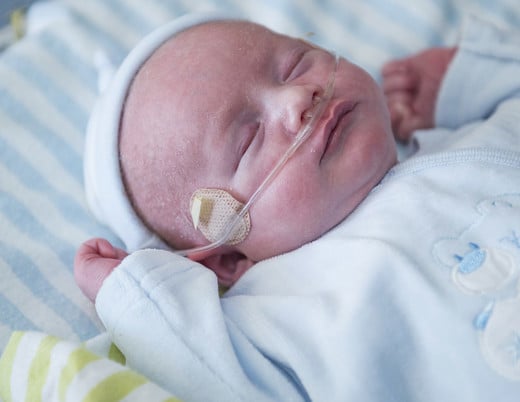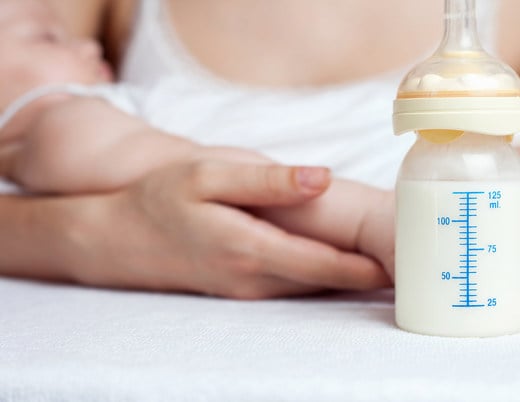Can breathing mitigate the stress of a prenatal diagnosis?
A fetal diagnosis can disrupt a family — and that disruption can have real downstream consequences. Psychologist Allison Dempsey, PhD, is trying to improve outcomes for babies by teaching their mothers how to breathe.
The stress of a fetal diagnosis
Not long ago, Dr. Dempsey witnessed a panic attack. The patient, a pregnant mother whose baby had been diagnosed with an intrauterine growth restriction, was hooked up to a fetal monitor at the time. Her baby needed monitoring several times a day. That's not unusual on units like the Colorado Fetal Care Center at Children's Hospital Colorado.
"But it can be really hard on mothers, especially if it's hard to find the baby's heartbeat," says Dr. Dempsey, former Director of Behavioral Health Programs at the Colorado Fetal Care Center and Children's Colorado's Level IV Neonatal Intensive Care Unit on Anschutz Medical Campus. "In this patient's case, her heart rate and blood pressure just shot up, and in response, the baby's heart rate actually started to decelerate, which can affect whether the baby needs to be delivered."
Fetal conditions are stressful. They interrupt families' lives, put new demands on their time and finances and alter their expectations of what parenthood might be. At Children's Colorado, a Center that serves several states, patients often have to travel long distances, separating them from family supports — all while they struggle with the emotional toll of expecting a baby with a complex condition.
How stress affects families
The stress of fetal diagnosis has real consequences: depression, anxiety, even post-traumatic stress disorder.
In the U.S., about 1 in 7 moms and 1 in 10 dads experiences some kind of perinatal mood or anxiety disorder. In fetal care units, those numbers more than double. In Colorado, the number-one cause of maternal mortality — more than preeclampsia or complications of delivery — is suicide.
Those consequences don't just affect the parents. They also affect the baby — whose health, by virtue of their diagnosis, is already fragile.
Aside from putting parents at risk for challenges and behaviors that can disrupt a baby's development, stress causes physiological changes. That’s especially concerning for mothers with a high-risk pregnancy, because what stresses the mother stresses the baby too.
But parents can counter those physiological manifestations. And one simple way to counter them is breath.
What variable heart rate means for stress
Slow, controlled diaphragmatic breathing produces an interesting phenomenon: It increases heart rate variability. The heart rate increases during breathing in and decreases during breathing out. It’s a remarkably consistent effect, and it correlates across many populations with better mental and physical health, even longer lives.
"When you breathe a little slower, a little deeper, a little softer and quieter, your blood vessels dilate, your blood pressure goes down," says Dr. Dempsey. "It calms the autonomic nervous system, sending signals back to your brain to relax."
Heart rate variability declines steadily during pregnancy for reasons possibly related to cardiovascular changes women undergo while they support a growing fetus: increases in blood volume, stroke volume and heart rate. But various studies have found that pregnant women can increase their heart rate variability by learning to self-regulate their breath using biofeedback, even during the peripartum period — a stressful time for any expecting mother.
Dr. Dempsey, one of just a handful of psychologists in the country embedded in a fetal care center, wanted to know if it would work under even more stressful conditions: after a fetal diagnosis.
"It's well established for anxiety," she says, "but never in this population."
Learning what it feels like to breathe
Biofeedback works a lot like a lie detector, tracking heart rate, respiration, muscle tension and skin conductance — all measures of anxiety and stress. For her purposes, Dr. Dempsey is starting with training respiratory rate and rhythm and heart rate variability using a five-session protocol.
"The average person breathes at about 12 to 18 breaths per minute," says Dr. Dempsey. "For optimal heart rate variability, the breath rate is somewhere around six per minute."
For most people, especially if they've never experimented with breath control, that slow a rate feels strange and can even induce feelings of dizziness, lightheadedness or oxygen hunger. With a patient hooked up to a pulse-oximeter and a respiratory monitor as a guide, Dr. Dempsey starts at around 14.
"Really our first session is to feel what diaphragmatic breathing feels like," says Dr. Dempsey, "and then to discern based on their perception what it feels like to breathe at one rate and what it feels like to slow it down."
Controlling heart rate variability
In later sessions, patients turn their attention to controlling their heart rate variability through their breath using a variety of programs and games. In one game, for example, patients can clarify a blurry picture by increasing their heart rate variability. And patients go home with apps they can use to practice the skills on their own.
Here's how Dr. Dempsey teaches her patients to do it:
- Patients start with a guide timing their breath to a pace slightly slower than normal, 14 breaths per minute.
- Patients get direct feedback on their breathing in the form of a curve they can see in real time and compare to the guide on their screen.
- Staying in touch with their comfort level, patients go through a number of exercises elongating various points of the breath: the inhale and the exhale, but also holding at the top and spending a couple of seconds "empty" at the bottom.
- After a few sessions, once they've established their breathing practice, Dr. Dempsey takes patients through feedback sessions with programs and games directly connected to heart-rate variability.
Validating through study
So far, results have been good, with patients reporting lower stress levels as a result. Dr. Dempsey hopes to quantify those measures over time.
For now, she's recording objective outcomes data — does heart rate variability improve with practice? — as well as more subjective measures of stress, anxiety, depression and post-traumatic stress symptoms. She's also working on a research protocol, in which she hopes to follow subjects for at least a year, looking at how they respond to the intervention and whether they continue to use the skills they've learned.
"Most of the mothers in our center are facing very real and very stressful, uncertain situations. So much feels out of their control," says Dr. Dempsey. "We're giving them something tangible they can use to focus on their physical reactions and change their mental health.
"It can't just be an afterthought," she adds. "Mental health affects physical health. We need to address it in real time."
Advancing care beyond Colorado
As a leader in her field, Dr. Dempsey is co-chair of the Early Childhood Special Interest Group of the Society for Developmental and Behavioral Pediatrics, a work group interested in the medical and developmental outcomes of children born with medical complications.
She's also co-chair of the National Network of NICU Psychologists, which seeks to optimize care for infants and their families in NICU settings through family involvement, staff support, research and intervention.





 720-777-0123
720-777-0123










